#graeae
Text
Greek monster myths (1)
Various mini-articles loosely translated from the French « Dictionary of Feminine Myths », under the direction of Pierre Brunel. (You could also translate the title as “Dictionary of Female Myths” – the idea being all the myths centered around women)

Article 1: Gorgô
[Note: this mini-article is distinct from the mini-article about “Gorgons”]
The appearance of Gorgô, at the end of the eleventh chant of the Odyssey, is meant to cause fright – not just to Odysseus himself who is just done with invoking the dead, but also to the audience hearing this rhapsody (the Phaeacians listening to Odysseus’ tale), and to the very listener of the Homeric poem. Gorgô forms the dominant peak of this “evocation of the dead” (nekuia), she is the “chlôron déos”, the “green fear”. Odysseus’ mother, Anticleia, just disappeared back again nto the Hades – the hero wishes to summon other shades, such as those of Theseus and of his former companion Pirithous, “but before them, here is that with hellish cries the uncountable tribes of the dead gathered”. And Odysseus adds: “I felt myself becoming green with fear at the thought that, from the depths of the Hades, the noble Persephone might sent us the head of Gorgô, this terrible monster…” (633-635). It is barely an apparition, it is the possibility of an appearance, but it is enough to terrorize the living.
Jean-Pierre Vernant, in his work “La Mort dans les yeux” (Death in the eyes), establishes the link which ties together Gorgô and Medusa. Because Gorgô is more than a singular unification of the three Gorgons: she is a superlative form of Medusa, she is what happens when her petrifying gaze survives beyond death. By studying the depictions of Gorgô in ancient statues, Vernant establishes two fundamental traits: the faciality, and the monstrosity. He explains that “interferences” take place “between the human and the bestial, associated and mixed in diverse ways”. Maybe Gorgô is, as Vernant suggests, “the dark face, the sinister reverse of the Great Goddess, of which Artemis will most notably be the heir”. But Gorgô is also placed in the function of watchful guardian of the world of the dead, a world forbidden to the living. The mask of Gorgô expresses the radical alterity of Death and the dead.

Article 2: The Graeae
Daughters of Keto and Phorkys (they are thus also called “The Phorcydes”), sisters of the Gorgons, these divinities of shadows, which were born as elderly women and doomed to share one eye and one tooth for all three, appear exclusively in the tale of Perseus and Medusa.
The most ancient mention of the Graeae comes from Hesiod’s Theogony, which only counts two of them and names them Pemphredo and Enyo (Enyo was also the name of a goddess of war within Homer’s Iliad). The third of the sisters appears within a fragment of the Athenian logographer Pherecyde: Deino (“The Dreadful”), later called Persis by Hyginus (in his “Preface to fables”). Other authors, like Ovid, prefer to stick with two Graeae. Hesiod makes a quite flattering portrait of them: he makes them elegant goddesses with a “beautiful face”, even though they were “white-haired (understand “having white hair due to old age”) since birth”. And while their very name means “old women”, the Antique iconography actually follows the Hesiodic model: the depictions of the sisters as disfigured by the effects of time are quite rare… At most the artists will just put a few wrinkles. These mysterious hybrids between youth and old age, virginal seduction and sinister ugliness, finds an echo within a few lines from Aeschylus “Prometheus bound”: “Three ancient maidens, with swan bodies, that share a single eye and a single tooth, and who never receive a look from the shinng sun or the crescent of the night.” Aeschylus had an entire tragedy written about them (Phorcydes) which was unfortunately lost – but Aristotle wrote about it in his “Poetics” and implies that the play insisted on their monstrous aspect, placing them within the legendary area known as “the gorgonian fields of Kisthene”, and closely associating them with their sisters, of which they form a reversed image. Indeed, the Gorgons have a very powerful eyesight which no mortal being can face, while the Graeae have an extreme form of blindness. This trinity of women, old by nature, can also be understood as the antithesis of the three Charites, the Graces which embodied eternal youth.
The Graeae seems to have only a role within the myth of Perseus. And, outside of a few details, this legend does not change much from Pherecyde to Ovid’s Metamorphoses, passing by Lycophron, Apollodorus’ Bibliotheca, and Hyginus’ Astronomy. In all those versions the Graeae are the jealous keeper of the secret path that leads to the Gorgons, and Perseus must steal their eye in order to obtain the knowledge needed to reach Medusa. However, Pherecyde did change an element: according to him the Graeae do not protect the path leading to the Gorgons, but rather the path leading to the nymphs that hold the magical items Perseus needs to fight Medusa.
Due to their limited presence in Greek mythology, the Graeae have quite a poor cultural posterity. In the 19th century Goethe will remember them: in his “Second Faust”, Mephistopheles appears under the guise of “Phorkyas”, a monster with only one eye and one tooth. In the world of paintings, Edward Burne-Jones, who created a true “Perseus cycle”, had a strong interest for them: he worked for a very long time on a painting of the Graeae. Their face is barely visible, but the cloth that wraps itself around their body is menacing ; they are within an arid desert, under a dark sky heavy with clouds – they perform a sinister dance, in a mockery of the Graces. Perseus comes to steal their eyes, and the grey color that invades all the nuances of the picture symbolizes the unique presence of those strange crones, both disquieting and pitiable.

Article 3: Echidna
Echidna, “the viper”, is according to Hesiod the daughter of Phorkys and Keto, themselves born of Pontos, the Sea, and Gaia, the Earth. Echidna’s sisters are female monsters like her: the Graeae, and the Gorgons. Hesiod describes her as having half of the body of a “fair-cheeked nymph”, while the rest of her body is the one of an enormous, big, cruel, spotted and terrible snake which “lies within the secret depths of the divine earth”. Echidna as such belongs to this large mythological family of snake-women, of which the most famous case in France is the fairy Mélusine. But unlike Mélusine, Echidna can never leave the snake-half of her body, and thus a better French heir would be Marcel Aymé’s depiction of the vouivre with her cohort of vipers.
Theodore de Banville, when he imagines Hesiod scolding him for sanitizing Classical mythology, makes of Echidna the symbol of the archaic mythology: he tells him that he is “making a toy out of the history of the gods” by depicting Love as “a sweet child, free of carnivorous appetites, ignored by the Furies and by bloody Echidna”.
Echidna precisely appears as a being led by an amorous desire within Herodotus’ tales, that he claims to have collected among the Greeks of Pontus Euxinus: as Herakles was sleeping, Echidna steals his horses away. She only agrees to give them back if he sleeps with her. When Herakles leaves her, she tells him that she will bear three sons from their union. He advises them to only keep with her one that would be able to bend a bow just like him, and to force the others to leave. She does that, and this favorite son is supposed to be the one that created the Scythian people. This meeting between Herakles and Echidna might be derived from the famous encounters between Herakles and three of Echidna’s other children: the Nemean Lion, the Hydra of Lerna, and Cerberus.
In Aeschylus, Orestes compares his mother, Clytemnestra, to “a horrible viper”. Sophocles has Creon call Ismene, which he believes to have helped Antigone, “a viper that slid in my house against my will to drink my blood”. These examples show a link between the Ancient metaphorical speech, and the mythological allusions. Indeed, only the context can allow us to determine if these authors meant “viper” as a common name, or as a proper name: as “Viper”, “Echidna”. But it confirms the idea that, in Ancient Greece, Echidna is a monster born of an archaic fear of the women, and embodying their supposed perfidy.
#greek mythology#graeae#gorgon#gorgo#medusa#echidna#greek monsters#female monsters#ancient greek monsters#greek myths
76 notes
·
View notes
Text



So, among the many entities that they are, are Neil Gaiman's Three supposed to be also the Graeae? Or did I musunderstand?
#you know the ones that see past present and future#graeae#greek mythology#roman mythology#grayas#weird sisters#erinias#moiras#moirae#erynies#gracious ladies#hecate#the three#the sandman#sandman
17 notes
·
View notes
Photo
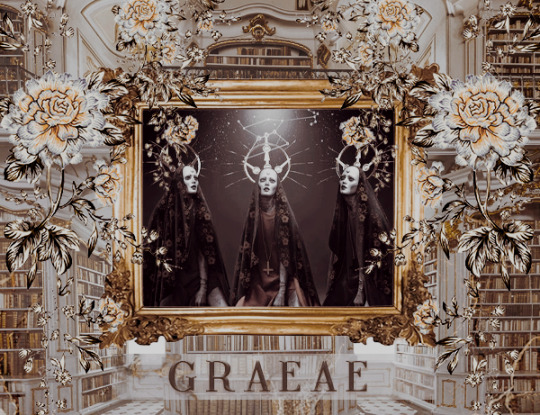
History
Primordial by nature, the Graeae, Fates, Norns, or Gray Sisters, have gone by many names over the centuries. At the inception of the Otherworld, either they came before Azathoth, or he came before them, but one created and the other foretold an infinity of possibilities. Identified as the Maiden, the Mother, and the Crone, the Graeae were the archetype from which the ancient elves, and later humanity, was caste. They wove the tapestries of fate and the vastness of the timelines that exist, the soul of each a thread in an unknowable pattern that only they could perceive in which all things are happening concurrently. It was the Graeae that determined the fate of all realms, across all timelines, throughout all versions of reality. When at long last the Graeae enter Uthenera, fate itself will slumber.
The Graeae dwell within the depths of Elysia, weaving and cackling and never intervening (when they can help it). Divinators, scryers, and clairvoyants invoke them - willingly or not - when their magic is enacted. It is these threads that the Graeae have woven that the practitioners of these branches of magic are grasping, some are able to perceive where that thread winds, where it tangles, snares, or stretches, while others can only feel a single fibre. Oracles receive their blessing directly from the Graeae, their reasons as unknowable as destiny itself, oracles are burdened with the responsibility of being focal points where many threads intertwine at once. In some sense, those most practised are able to influence fate and destiny as they see fit. However, across every timeline, there are some destinies that can never be avoided. Heroes, oracles, and individuals from the past who’ve sought the advice of the Fates have encountered projections of their will, rarely do the Graeae ever provide the advice someone is looking for.
Strengths
Deity soul.
Divine aura.
Divine force manipulation.
Flawless clairvoyance.
Flawless precognition.
Immune to illusion magic.
Weaknesses
Unable to physically leave Elysia.
Status: UNIQUE
2 notes
·
View notes
Photo
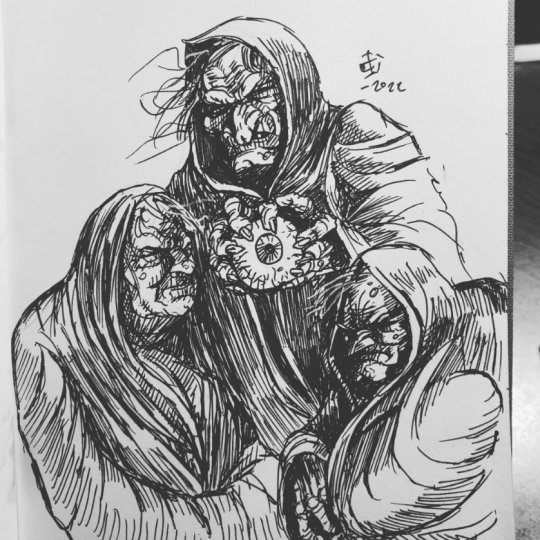
The Graeae and the eye they share.
4 notes
·
View notes
Text
Covenbane (Slayer Archetype)

Magic can be a source of great wonder, but also great malice and tragedy. Look no further than the foul magics of hags, their masculine skelm counterparts, and other wicked mystics for evidence of this.
Many do not survive such attentions, and those in their clutches may wish for death, especially if they are used for magical experimentation.
Some that do survive, however, gain a sort of sensitivity to magical auras, their old scars throbbing in the presence of magic, which proves a boon for those who seek to rid the world of such cruel magics and their practitioners. Some may be self-taught, while others might be recruited by goodly organizations and taught to hone their talents.
Regardless, these covenbane slayers are talented at punishing wicked spellcasters, particularly hags, witches, and other beings capable of forming covens.
Using their ability to sense beings capable of magic, these slayers are exceptionally capable of tracking and recognizing hags, spellcasters, and other magical beings, even when their true nature is disguised.
Able to sense the bonds between foes, they also prove capable of reading the behavior of an entire coven of hags or witches just by studying one, making them effective against all three at once. Later on, this extends to other mystical bonds as well.
Additionally, they also train to isolate and disrupt cooperation among spellcasters, making it much more difficult for them to work together.
Later on, they can use their senses to notice invisible foes as well, an fight effectively against them even if they cannot see them.
Strong against spellcasters and magical beings, this archetype can be a fun antithesis against a coven of hags, without changing it so much that it becomes unviable against other foes. If this appeals to you, I’d recommend a build focused on defense and offense against casters, such as disrupting their casting, as well as keeping out of their sensory range to avoid magical reprisal.
The most obvious character trait one can ascribe to these witch-hunters is their tendency to hate and fear not just evil magic, but most or even all magic. As antagonists they might seek to hunt down the party’s spellcasters under the assumption that they will inevitably use their powers for evil. As protagonists, they might let go of some of that hate as a way to achieve character growth, or they might not. Then again, they might be able to discern between benevolent magic and that which scarred them, even if they are never fully comfortable with it.
Once a devoted witch hunter, Liac went rogue when his latest target was revealed to be a young changeling girl. Now, he’ll do anything to protect her, but will the party accept a contract to capture him and the girl, or will they help him bring down the callous organization.
When people start disappearing near Hagfang Cave, many suspect that a new hag has taken residence in the cavern, drawn by the confluence of ley lines. However, in truth the culprit is a brutish buggane, a revelation that could cost the witch hunters delving within dearly unless warned in time.
Long has a hag coven tormented Shudana Rainforest, but while the grippli living nearby live in fear of them, the fact one of the coven’s members is a Graeae who’s predictions have saved them in the past, makes them hesitant to stand against them. However, as more and more of the frogfolk bear scars of the depredations of the sisters, it’s only a matter of time before one dares to stand against them.
10 notes
·
View notes
Text
INFLUENCES AND OTHER THINGS
Here's the July blog post, sliding in just under the wire! It's long, but hopefully entertaining!
I need to confess something: I never dreamed of being a writer. I wanted to be a surgeon, an astronaut,or a rock star when I was a little girl.
The doctor part went away when I realized that I’d have to touch people’s gooey innards. Yuck. Also,there was the acknowledgement that I would never be able to fix or save all my patients. I’m not a fanof failure and knowing that I would inevitably fail…
View On WordPress
0 notes
Text
love harringroveson for being like Graeae but instead of just one eye between them they have just one braincell
Only one of them can have A Thought (singular) at any given moment of time
Sometimes they lose the braincell though and one of the kids can have it dhhdd
And sometimes A Thought is just "damn my boyfriends are hot"
#graeae are those three old ladies form greek mythology that had one eye between them just in case#stranger things#billy hargrove#steve harrington#eddie munson#harringroveson#steddie#mungrove#harringrove#that's definitely a post
54 notes
·
View notes
Text
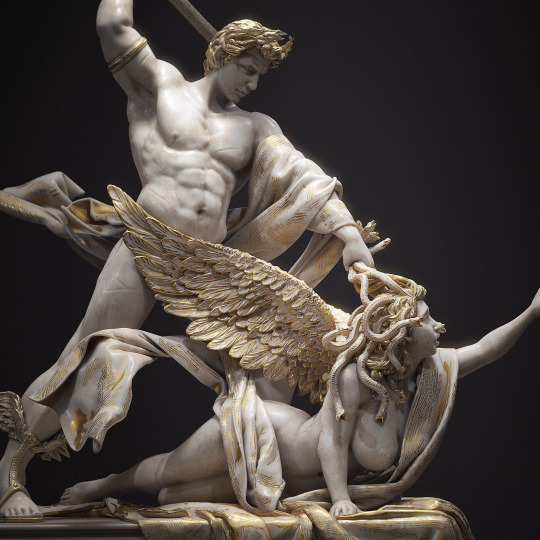
Medusa and Perseus by DocZenith. Source: DocZenith website
Perseus, Part 2
Hermes also helped Perseus, giving him an adamantine sickle with which to cut off Medusa’s head. But Perseus still needed a pair of winged sandals, a magic wallet to contain the decapitated head, and the dark helmet of invisibility which belonged to Hades. All these things were in the care of the Stygian Nymphs, from whom Perseus had to fetch them. (Perseus, The Greek Myths by Robert Graves, p 239).
Perseus located the Nymphs by outwitting the Gorgons’ sisters, the Graeae, three strange creatures who shared a single eye and tooth. By seizing both when they were being passed between the Graeae, Perseus refused to return tooth or eye until the sisters revealed the location of the Stygian Nymphs. They reluctantly did so and the hero swiftly collected wallet, sandals and helmet from the Nymphs. Perseus then flew to the land of the Gorgons. He confronted Medusa, and avoided her fatal gaze by locating her in the reflection of his polished shield. As Medusa approached him, Perseus then removed the Gorgon’s head with an arcing blow of his curved sword. To his surprise the mighty horse Pegasus emerged from her dead body, the steed being the offspring of Medusa and Poseidon. The other Gorgons emerged to avenge their fallen kin, so Perseus fled, dropping Medusa’s head into the wallet and mounting Pegasus to fly him away from that infernal place.
4 notes
·
View notes
Text
Whennnnn the moon rises high and they’re sharing one eye
That’s the Moirai
When they spool out their thread and then cut people dead
That’s the Moirai
#no I don’t know why my conversation with my spouse devolved into this#yes I know that the movie Hercules conflated the Moirai with the Graeae#rhyme over mythology baby
15 notes
·
View notes
Photo
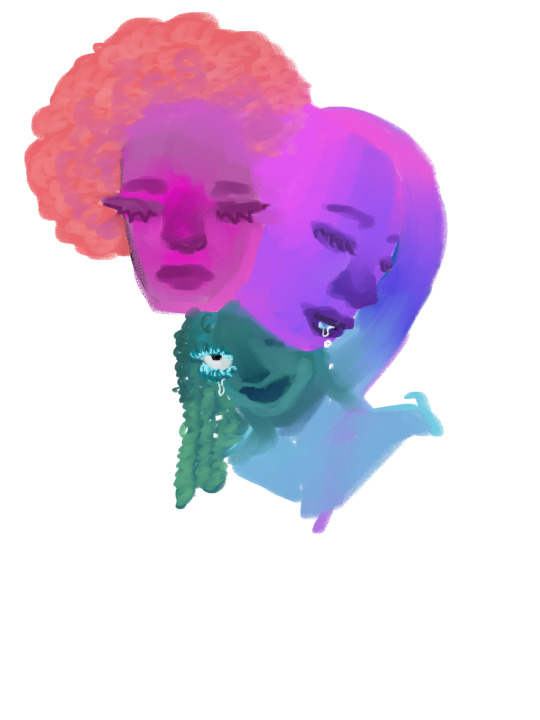
The Graeae, three mythical women who shared an eye and a tooth
A fun little drawing challenge :)
2 notes
·
View notes
Photo

This is how I imagined the Grey Sisters, the three monstrous daughters of Phorcys and Ceto and sisters of the Gorgon Sisters
4 notes
·
View notes
Text
"why are the graeae described as the daughters of phorcys" idk cus he gave birth to them tf do u want me to say
1 note
·
View note
Text
okay re: previous post I love the hc of Jason being able to talk to birds but my extremely silly caveat i like to put on it is that Jason is capable of talking to swans, but swans HATE HIM. They have like, a personal vendetta against Zeus/Jupiter and they won't outright attack Jason but they do refuse to talk to him. They will literally give him the silent treatment and do the whole "Hm? Did somebody say something? I didn't hear U_U"
On the other hand though, Reyna can talk to only swans specifically, because Bellona/Enyo is one of the Graeae and they can turn into swans. So every time Jason has to talk to a swan he has to ask Reyna to talk to them for him.
177 notes
·
View notes
Text
ceto, the sea goddess (asteroid 65489)
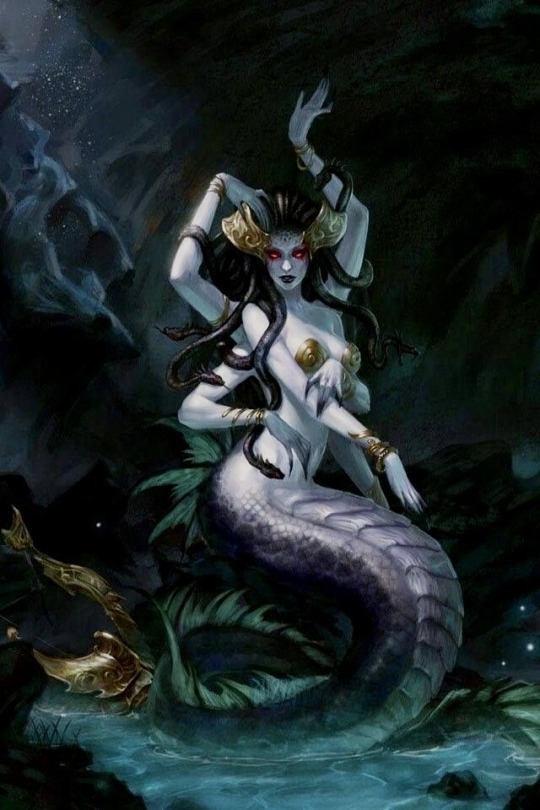
Keto is the daughter of the titans Pontus and Gaea. As a primordial being, Keto was meant to represent the dangers of the sea. Infamously, she is known for having marriage Phorcys with whom she had the Phorcydes, also known as the monsters of the sea - Gorgons (Medusa included), Echidna, Ladon, Graeae, etc. IN MY OPINION Ceto in your chart can represent a) how you are seen as evil, b) what you produce that others find evil, c) your fertility, and/or d) your relationship with the ocean and its darkest depths.

i encourage you to look into the aspects of ceto along with the sign, degree, and house placement. for the more advanced astrologers, take a look at the persona chart of ceto AND/OR add the other characters involved to see how they support or impede ceto!
OTHER RELATED ASTEROIDS: gaea (1184) and medusa (149)!
like what you read? leave a tip and state what post it is for! please use my "suggest a post topic" button if you want to see a specific post or mythical asteroid next!
click here for the masterlist
click here for more greek myths & legends
want a personal reading? click here to check out my reading options and prices!
#astrology#astro community#astro placements#astro chart#asteroid astrology#asteroid#natal chart#persona chart#greek mythology#astrology tumblr#astro observations#astro notes#natal astrology#astroblr#astrology readings#ceto#keto#asteroid65489#gaea#asteroid1184#medusa#asteroid149
165 notes
·
View notes
Text
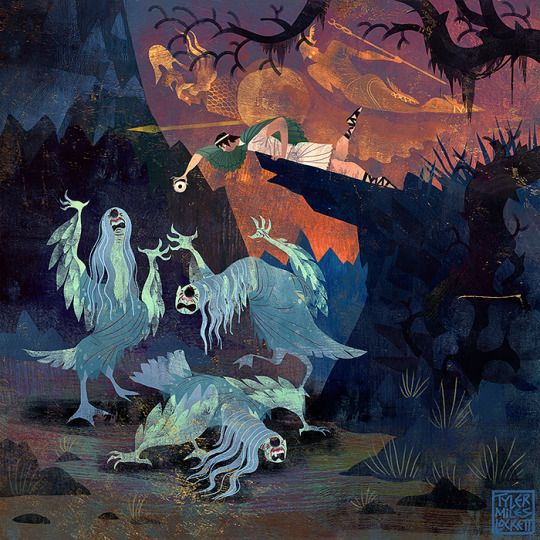
The Sisters Graeae (#4 in my "Quest firnthe Gorgon Head" series)
As Perseus was the son of Zeus, the gods heard his prayers. Athena answered, offering strategic information on the only ones who knew the locations of the The Gorgon sisters, were in fact, another set of three sisters; the sisters Graeae. These are three gray haired old hags with swan like bodies, who share but one eye and tooth between them. Hermes, God of travelers and ally to mortals, also offered his guidance to the distant realm. After many weeks of difficult trekking, Perseus found himself on the island of Cisthene, in the craggy land of the sisters Graeae. Sneaking upon the women, he waited until they passed their one eye between them, snatching it away, and threatening to heave it into the sea. The Graeae gave in, revealing the location of the Gorgon sisters. But it would be no easy task. The gorgon sisters had golden wings, bronze hands, snakes for hair, and worst of all, their gazes turned men to stone. Perseus would need sacred weapons for such a mission. And, according to Athena, there was only one group who could provide them: the sea nymphs.
With the 3 sisters we can see the first of many examples of the “triple goddess” archetype in Old world mythology. Some are represented with one body and three forms (triple bodied Hekate) while most are three individuals. (i.e. “The Morai” (fates), “the Horai” (seasons) “The Furies,” “The Hesperides,”(graces) and “the Gorgons.”) We can see other examples from other ancient cultures, like the Norse “Norns” or the Christian holy trinity of the father, son, and holy spirit. Even Shakespeare, a student of Greek myth and poetry, chose three witches to prophecy to Macbeth.
Like this art? It will be in my illustrated book with over 130 other full page illustrations coming in June to kickstarter. to get unseen free hi-hes art subscribe to my email newsletter
Follow my backerkit kickstarter notification page.
Thank you for supporting independent artists! 🤘❤️🏛😁
#greekmythology#greekgods#pjo#mythology#classics#classicscommunity#myths#ancientgreece#danae#perseus#medusa#gorgon#classicliterature#classicnovels#tylermileslockett#greekmyths#darkmyths#darkfairytales
50 notes
·
View notes
Note
So, among the many entities that they are, are the Three (/Moirae/Hecate/weird sisters) supposed to be also the Graeae? Or did I musunderstand?
Yes. As long as it's a version of the Graeae with three women in it...
524 notes
·
View notes